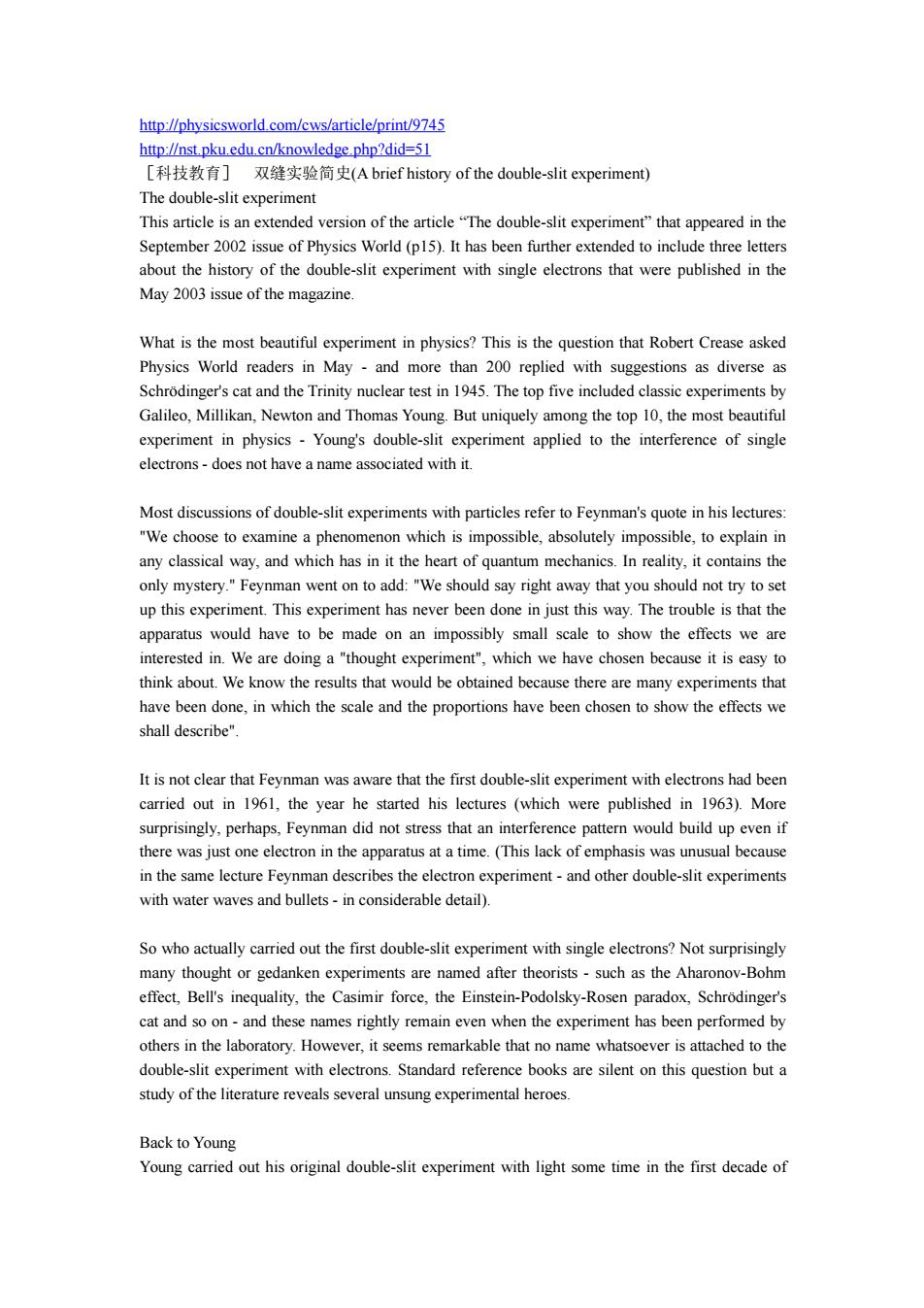
http://physicsworld.com/cws/article/print/9745 http://nst.pku.edu.cn/knowledge.php?did=51 [科技教育]双缝实验简史(A brief history of the double--slit experiment) The double-slit experiment This article is an extended version of the article "The double-slit experiment"that appeared in the September 2002 issue of Physics World(p15).It has been further extended to include three letters about the history of the double-slit experiment with single electrons that were published in the May 2003 issue of the magazine. What is the most beautiful experiment in physics?This is the question that Robert Crease asked Physics World readers in May -and more than 200 replied with suggestions as diverse as Schrodinger's cat and the Trinity nuclear test in 1945.The top five included classic experiments by Galileo,Millikan,Newton and Thomas Young.But uniquely among the top 10,the most beautiful experiment in physics -Young's double-slit experiment applied to the interference of single electrons-does not have a name associated with it. Most discussions of double-slit experiments with particles refer to Feynman's quote in his lectures: "We choose to examine a phenomenon which is impossible,absolutely impossible,to explain in any classical way,and which has in it the heart of quantum mechanics.In reality,it contains the only mystery."Feynman went on to add:"We should say right away that you should not try to set up this experiment.This experiment has never been done in just this way.The trouble is that the apparatus would have to be made on an impossibly small scale to show the effects we are interested in.We are doing a"thought experiment",which we have chosen because it is easy to think about.We know the results that would be obtained because there are many experiments that have been done,in which the scale and the proportions have been chosen to show the effects we shall describe" It is not clear that Feynman was aware that the first double-slit experiment with electrons had been carried out in 1961,the year he started his lectures (which were published in 1963).More surprisingly,perhaps,Feynman did not stress that an interference pattern would build up even if there was just one electron in the apparatus at a time.(This lack of emphasis was unusual because in the same lecture Feynman describes the electron experiment-and other double-slit experiments with water waves and bullets-in considerable detail). So who actually carried out the first double-slit experiment with single electrons?Not surprisingly many thought or gedanken experiments are named after theorists-such as the Aharonov-Bohm effect,Bell's inequality,the Casimir force,the Einstein-Podolsky-Rosen paradox,Schrodinger's cat and so on-and these names rightly remain even when the experiment has been performed by others in the laboratory.However,it seems remarkable that no name whatsoever is attached to the double-slit experiment with electrons.Standard reference books are silent on this question but a study of the literature reveals several unsung experimental heroes. Back to Young Young carried out his original double-slit experiment with light some time in the first decade of
http://physicsworld.com/cws/article/print/9745 http://nst.pku.edu.cn/knowledge.php?did=51 [科技教育] 双缝实验简史(A brief history of the double-slit experiment) The double-slit experiment This article is an extended version of the article “The double-slit experiment” that appeared in the September 2002 issue of Physics World (p15). It has been further extended to include three letters about the history of the double-slit experiment with single electrons that were published in the May 2003 issue of the magazine. What is the most beautiful experiment in physics? This is the question that Robert Crease asked Physics World readers in May - and more than 200 replied with suggestions as diverse as Schrödinger's cat and the Trinity nuclear test in 1945. The top five included classic experiments by Galileo, Millikan, Newton and Thomas Young. But uniquely among the top 10, the most beautiful experiment in physics - Young's double-slit experiment applied to the interference of single electrons - does not have a name associated with it. Most discussions of double-slit experiments with particles refer to Feynman's quote in his lectures: "We choose to examine a phenomenon which is impossible, absolutely impossible, to explain in any classical way, and which has in it the heart of quantum mechanics. In reality, it contains the only mystery." Feynman went on to add: "We should say right away that you should not try to set up this experiment. This experiment has never been done in just this way. The trouble is that the apparatus would have to be made on an impossibly small scale to show the effects we are interested in. We are doing a "thought experiment", which we have chosen because it is easy to think about. We know the results that would be obtained because there are many experiments that have been done, in which the scale and the proportions have been chosen to show the effects we shall describe". It is not clear that Feynman was aware that the first double-slit experiment with electrons had been carried out in 1961, the year he started his lectures (which were published in 1963). More surprisingly, perhaps, Feynman did not stress that an interference pattern would build up even if there was just one electron in the apparatus at a time. (This lack of emphasis was unusual because in the same lecture Feynman describes the electron experiment - and other double-slit experiments with water waves and bullets - in considerable detail). So who actually carried out the first double-slit experiment with single electrons? Not surprisingly many thought or gedanken experiments are named after theorists - such as the Aharonov-Bohm effect, Bell's inequality, the Casimir force, the Einstein-Podolsky-Rosen paradox, Schrödinger's cat and so on - and these names rightly remain even when the experiment has been performed by others in the laboratory. However, it seems remarkable that no name whatsoever is attached to the double-slit experiment with electrons. Standard reference books are silent on this question but a study of the literature reveals several unsung experimental heroes. Back to Young Young carried out his original double-slit experiment with light some time in the first decade of
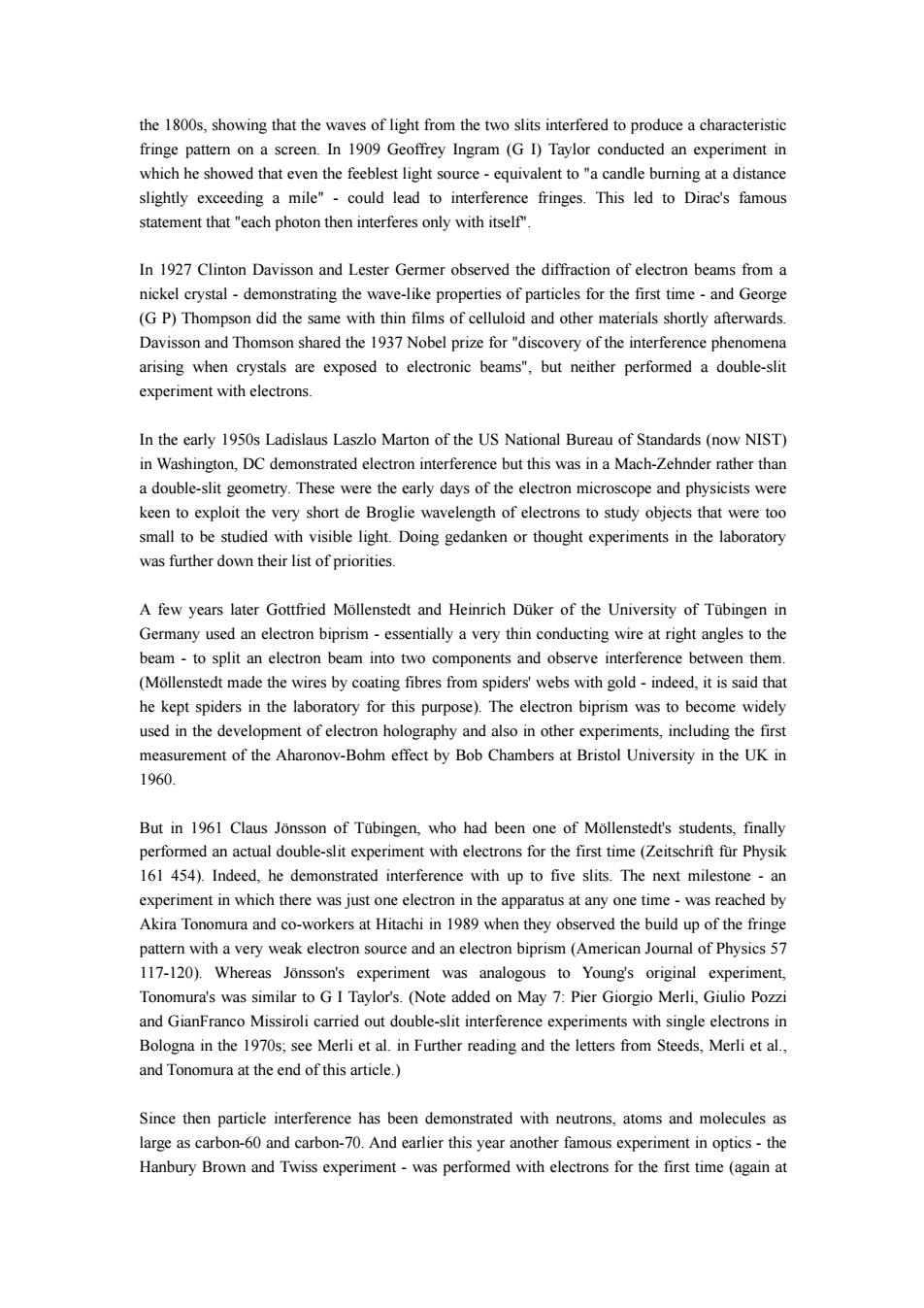
the 1800s,showing that the waves of light from the two slits interfered to produce a characteristic fringe pattern on a screen.In 1909 Geoffrey Ingram(G I)Taylor conducted an experiment in which he showed that even the feeblest light source-equivalent to "a candle burning at a distance slightly exceeding a mile"-could lead to interference fringes.This led to Dirac's famous statement that"each photon then interferes only with itself" In 1927 Clinton Davisson and Lester Germer observed the diffraction of electron beams from a nickel crystal-demonstrating the wave-like properties of particles for the first time and George (G P)Thompson did the same with thin films of celluloid and other materials shortly afterwards. Davisson and Thomson shared the 1937 Nobel prize for "discovery of the interference phenomena arising when crystals are exposed to electronic beams",but neither performed a double-slit experiment with electrons. In the early 1950s Ladislaus Laszlo Marton of the US National Bureau of Standards(now NIST) in Washington,DC demonstrated electron interference but this was in a Mach-Zehnder rather than a double-slit geometry.These were the early days of the electron microscope and physicists were keen to exploit the very short de Broglie wavelength of electrons to study objects that were too small to be studied with visible light.Doing gedanken or thought experiments in the laboratory was further down their list of priorities. A few years later Gottfried Mollenstedt and Heinrich Duker of the University of Tubingen in Germany used an electron biprism-essentially a very thin conducting wire at right angles to the beam-to split an electron beam into two components and observe interference between them. (Mollenstedt made the wires by coating fibres from spiders'webs with gold-indeed,it is said that he kept spiders in the laboratory for this purpose).The electron biprism was to become widely used in the development of electron holography and also in other experiments,including the first measurement of the Aharonov-Bohm effect by Bob Chambers at Bristol University in the UK in 1960. But in 1961 Claus Jonsson of Tubingen,who had been one of Mollenstedt's students,finally performed an actual double-slit experiment with electrons for the first time(Zeitschrift fur Physik 161 454).Indeed,he demonstrated interference with up to five slits.The next milestone-an experiment in which there was just one electron in the apparatus at any one time-was reached by Akira Tonomura and co-workers at Hitachi in 1989 when they observed the build up of the fringe pattern with a very weak electron source and an electron biprism(American Journal of Physics 57 117-120).Whereas Jonsson's experiment was analogous to Young's original experiment, Tonomura's was similar to G I Taylor's.(Note added on May 7:Pier Giorgio Merli,Giulio Pozzi and GianFranco Missiroli carried out double-slit interference experiments with single electrons in Bologna in the 1970s:see Merli et al.in Further reading and the letters from Steeds,Merli et al., and Tonomura at the end of this article. Since then particle interference has been demonstrated with neutrons,atoms and molecules as large as carbon-60 and carbon-70.And earlier this year another famous experiment in optics-the Hanbury Brown and Twiss experiment -was performed with electrons for the first time (again at
the 1800s, showing that the waves of light from the two slits interfered to produce a characteristic fringe pattern on a screen. In 1909 Geoffrey Ingram (G I) Taylor conducted an experiment in which he showed that even the feeblest light source - equivalent to "a candle burning at a distance slightly exceeding a mile" - could lead to interference fringes. This led to Dirac's famous statement that "each photon then interferes only with itself". In 1927 Clinton Davisson and Lester Germer observed the diffraction of electron beams from a nickel crystal - demonstrating the wave-like properties of particles for the first time - and George (G P) Thompson did the same with thin films of celluloid and other materials shortly afterwards. Davisson and Thomson shared the 1937 Nobel prize for "discovery of the interference phenomena arising when crystals are exposed to electronic beams", but neither performed a double-slit experiment with electrons. In the early 1950s Ladislaus Laszlo Marton of the US National Bureau of Standards (now NIST) in Washington, DC demonstrated electron interference but this was in a Mach-Zehnder rather than a double-slit geometry. These were the early days of the electron microscope and physicists were keen to exploit the very short de Broglie wavelength of electrons to study objects that were too small to be studied with visible light. Doing gedanken or thought experiments in the laboratory was further down their list of priorities. A few years later Gottfried Möllenstedt and Heinrich Düker of the University of Tübingen in Germany used an electron biprism - essentially a very thin conducting wire at right angles to the beam - to split an electron beam into two components and observe interference between them. (Möllenstedt made the wires by coating fibres from spiders' webs with gold - indeed, it is said that he kept spiders in the laboratory for this purpose). The electron biprism was to become widely used in the development of electron holography and also in other experiments, including the first measurement of the Aharonov-Bohm effect by Bob Chambers at Bristol University in the UK in 1960. But in 1961 Claus Jönsson of Tübingen, who had been one of Möllenstedt's students, finally performed an actual double-slit experiment with electrons for the first time (Zeitschrift für Physik 161 454). Indeed, he demonstrated interference with up to five slits. The next milestone - an experiment in which there was just one electron in the apparatus at any one time - was reached by Akira Tonomura and co-workers at Hitachi in 1989 when they observed the build up of the fringe pattern with a very weak electron source and an electron biprism (American Journal of Physics 57 117-120). Whereas Jönsson's experiment was analogous to Young's original experiment, Tonomura's was similar to G I Taylor's. (Note added on May 7: Pier Giorgio Merli, Giulio Pozzi and GianFranco Missiroli carried out double-slit interference experiments with single electrons in Bologna in the 1970s; see Merli et al. in Further reading and the letters from Steeds, Merli et al., and Tonomura at the end of this article.) Since then particle interference has been demonstrated with neutrons, atoms and molecules as large as carbon-60 and carbon-70. And earlier this year another famous experiment in optics - the Hanbury Brown and Twiss experiment - was performed with electrons for the first time (again at
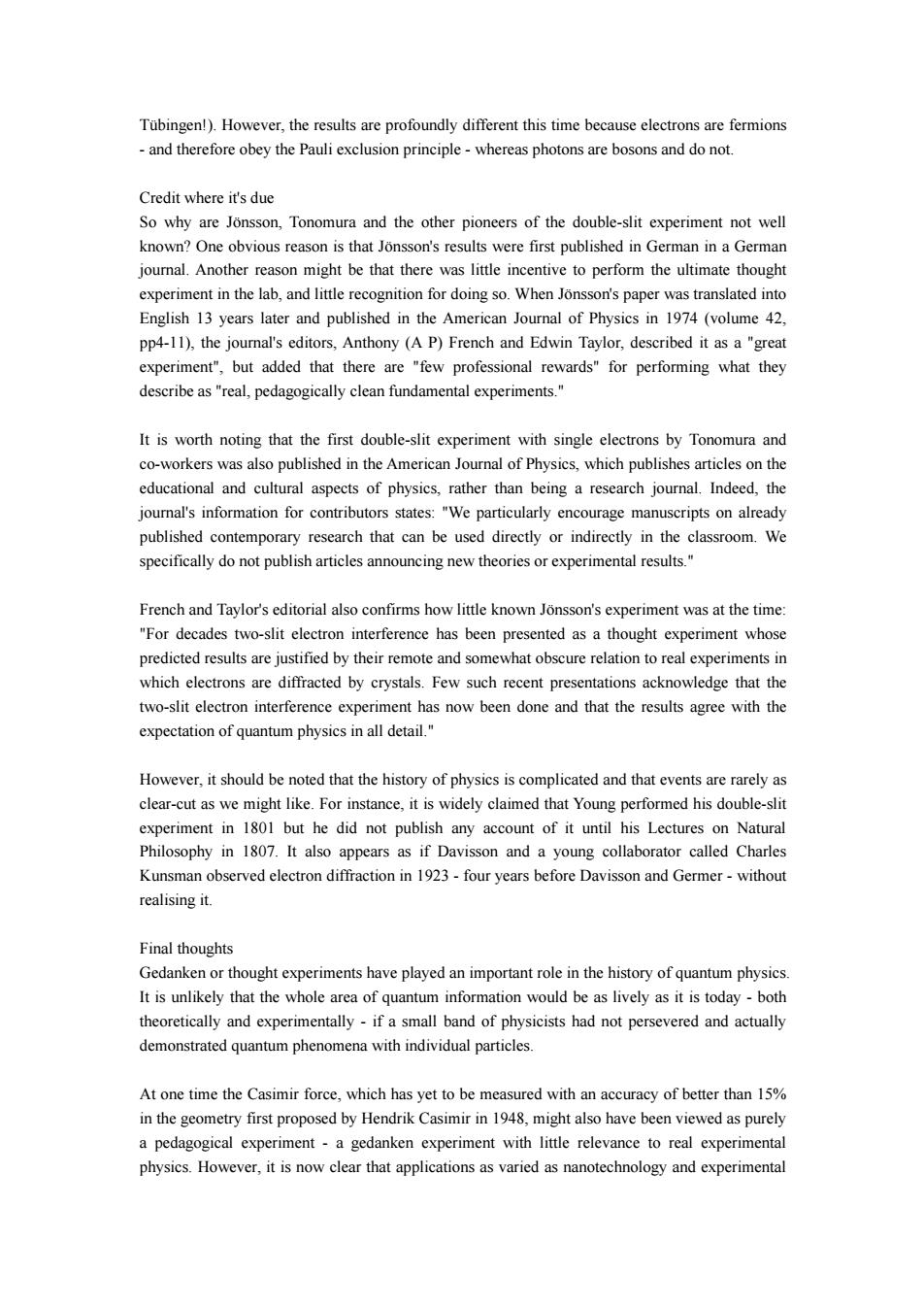
Tubingen!).However,the results are profoundly different this time because electrons are fermions -and therefore obey the Pauli exclusion principle-whereas photons are bosons and do not. Credit where it's due So why are Jonsson,Tonomura and the other pioneers of the double-slit experiment not well known?One obvious reason is that Jonsson's results were first published in German in a German journal.Another reason might be that there was little incentive to perform the ultimate thought experiment in the lab,and little recognition for doing so.When Jonsson's paper was translated into English 13 years later and published in the American Journal of Physics in 1974(volume 42, pp4-11),the journal's editors,Anthony(A P)French and Edwin Taylor,described it as a "great experiment",but added that there are "few professional rewards"for performing what they describe as"real,pedagogically clean fundamental experiments." It is worth noting that the first double-slit experiment with single electrons by Tonomura and co-workers was also published in the American Journal of Physics,which publishes articles on the educational and cultural aspects of physics,rather than being a research journal.Indeed,the journal's information for contributors states:"We particularly encourage manuscripts on already published contemporary research that can be used directly or indirectly in the classroom.We specifically do not publish articles announcing new theories or experimental results." French and Taylor's editorial also confirms how little known Jonsson's experiment was at the time: "For decades two-slit electron interference has been presented as a thought experiment whose predicted results are justified by their remote and somewhat obscure relation to real experiments in which electrons are diffracted by crystals.Few such recent presentations acknowledge that the two-slit electron interference experiment has now been done and that the results agree with the expectation of quantum physics in all detail." However,it should be noted that the history of physics is complicated and that events are rarely as clear-cut as we might like.For instance,it is widely claimed that Young performed his double-slit experiment in 1801 but he did not publish any account of it until his Lectures on Natural Philosophy in 1807.It also appears as if Davisson and a young collaborator called Charles Kunsman observed electron diffraction in 1923-four years before Davisson and Germer-without realising it. Final thoughts Gedanken or thought experiments have played an important role in the history of quantum physics. It is unlikely that the whole area of quantum information would be as lively as it is today-both theoretically and experimentally-if a small band of physicists had not persevered and actually demonstrated quantum phenomena with individual particles. At one time the Casimir force,which has yet to be measured with an accuracy of better than 15% in the geometry first proposed by Hendrik Casimir in 1948,might also have been viewed as purely a pedagogical experiment-a gedanken experiment with little relevance to real experimental physics.However,it is now clear that applications as varied as nanotechnology and experimental
Tübingen!). However, the results are profoundly different this time because electrons are fermions - and therefore obey the Pauli exclusion principle - whereas photons are bosons and do not. Credit where it's due So why are Jönsson, Tonomura and the other pioneers of the double-slit experiment not well known? One obvious reason is that Jönsson's results were first published in German in a German journal. Another reason might be that there was little incentive to perform the ultimate thought experiment in the lab, and little recognition for doing so. When Jönsson's paper was translated into English 13 years later and published in the American Journal of Physics in 1974 (volume 42, pp4-11), the journal's editors, Anthony (A P) French and Edwin Taylor, described it as a "great experiment", but added that there are "few professional rewards" for performing what they describe as "real, pedagogically clean fundamental experiments." It is worth noting that the first double-slit experiment with single electrons by Tonomura and co-workers was also published in the American Journal of Physics, which publishes articles on the educational and cultural aspects of physics, rather than being a research journal. Indeed, the journal's information for contributors states: "We particularly encourage manuscripts on already published contemporary research that can be used directly or indirectly in the classroom. We specifically do not publish articles announcing new theories or experimental results." French and Taylor's editorial also confirms how little known Jönsson's experiment was at the time: "For decades two-slit electron interference has been presented as a thought experiment whose predicted results are justified by their remote and somewhat obscure relation to real experiments in which electrons are diffracted by crystals. Few such recent presentations acknowledge that the two-slit electron interference experiment has now been done and that the results agree with the expectation of quantum physics in all detail." However, it should be noted that the history of physics is complicated and that events are rarely as clear-cut as we might like. For instance, it is widely claimed that Young performed his double-slit experiment in 1801 but he did not publish any account of it until his Lectures on Natural Philosophy in 1807. It also appears as if Davisson and a young collaborator called Charles Kunsman observed electron diffraction in 1923 - four years before Davisson and Germer - without realising it. Final thoughts Gedanken or thought experiments have played an important role in the history of quantum physics. It is unlikely that the whole area of quantum information would be as lively as it is today - both theoretically and experimentally - if a small band of physicists had not persevered and actually demonstrated quantum phenomena with individual particles. At one time the Casimir force, which has yet to be measured with an accuracy of better than 15% in the geometry first proposed by Hendrik Casimir in 1948, might also have been viewed as purely a pedagogical experiment - a gedanken experiment with little relevance to real experimental physics. However, it is now clear that applications as varied as nanotechnology and experimental
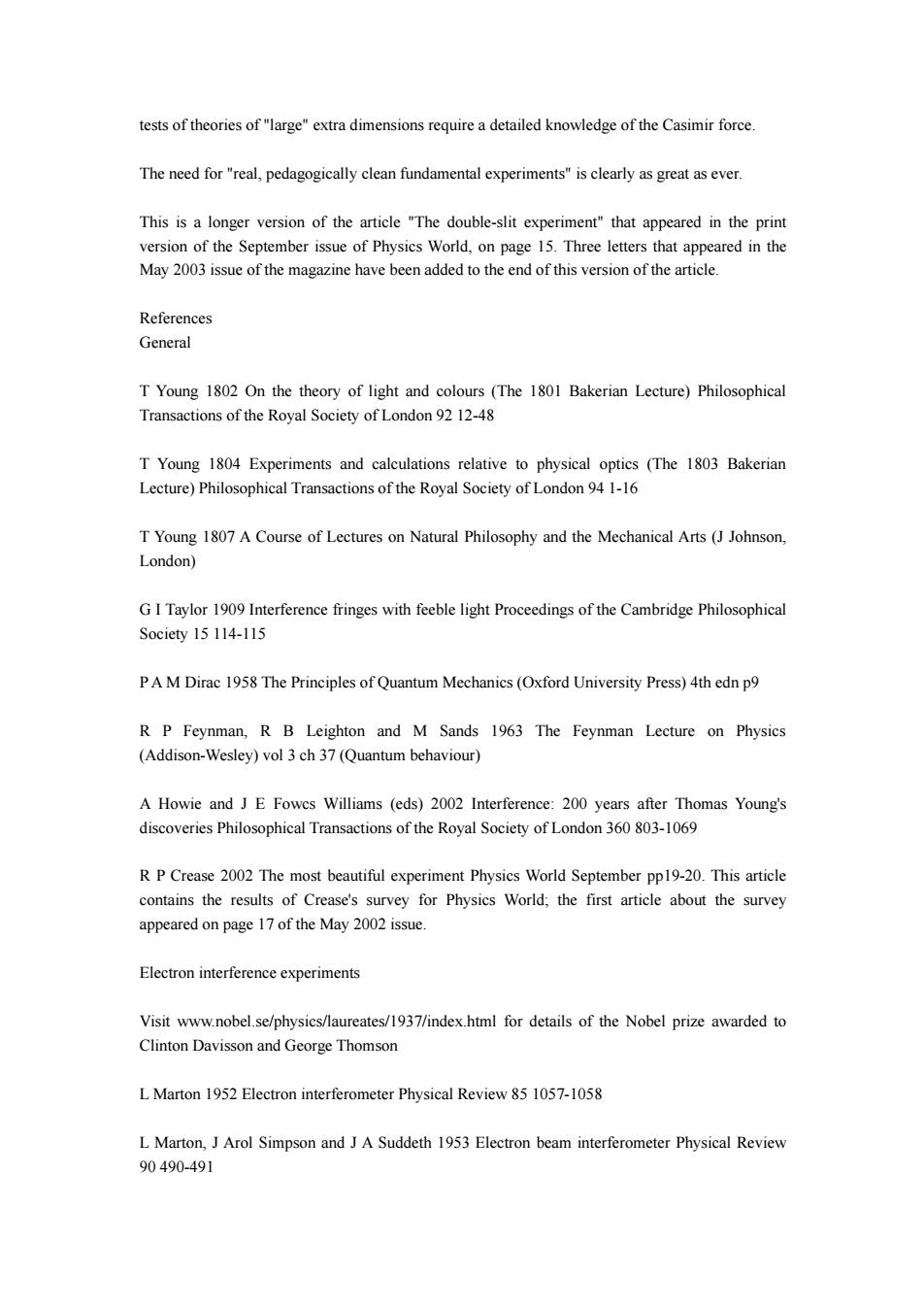
tests of theories of "large"extra dimensions require a detailed knowledge of the Casimir force. The need for"real,pedagogically clean fundamental experiments"is clearly as great as ever. This is a longer version of the article "The double-slit experiment"that appeared in the print version of the September issue of Physics World,on page 15.Three letters that appeared in the May 2003 issue of the magazine have been added to the end of this version of the article. References General T Young 1802 On the theory of light and colours(The 1801 Bakerian Lecture)Philosophical Transactions of the Royal Society of London 92 12-48 T Young 1804 Experiments and calculations relative to physical optics (The 1803 Bakerian Lecture)Philosophical Transactions of the Royal Society of London 94 1-16 T Young 1807 A Course of Lectures on Natural Philosophy and the Mechanical Arts (J Johnson, London) G I Taylor 1909 Interference fringes with feeble light Proceedings of the Cambridge Philosophical Society 15 114-115 PA M Dirac 1958 The Principles of Quantum Mechanics(Oxford University Press)4th edn p9 R P Feynman,R B Leighton and M Sands 1963 The Feynman Lecture on Physics (Addison-Wesley)vol 3 ch 37(Quantum behaviour) A Howie and J E Fowcs Williams (eds)2002 Interference:200 years after Thomas Young's discoveries Philosophical Transactions of the Royal Society of London 360 803-1069 R P Crease 2002 The most beautiful experiment Physics World September pp19-20.This article contains the results of Crease's survey for Physics World;the first article about the survey appeared on page 17 of the May 2002 issue. Electron interference experiments Visit www.nobel.se/physics/laureates/1937/index.html for details of the Nobel prize awarded to Clinton Davisson and George Thomson L Marton 1952 Electron interferometer Physical Review 85 1057-1058 L Marton,J Arol Simpson and J A Suddeth 1953 Electron beam interferometer Physical Review 90490-491
tests of theories of "large" extra dimensions require a detailed knowledge of the Casimir force. The need for "real, pedagogically clean fundamental experiments" is clearly as great as ever. This is a longer version of the article "The double-slit experiment" that appeared in the print version of the September issue of Physics World, on page 15. Three letters that appeared in the May 2003 issue of the magazine have been added to the end of this version of the article. References General T Young 1802 On the theory of light and colours (The 1801 Bakerian Lecture) Philosophical Transactions of the Royal Society of London 92 12-48 T Young 1804 Experiments and calculations relative to physical optics (The 1803 Bakerian Lecture) Philosophical Transactions of the Royal Society of London 94 1-16 T Young 1807 A Course of Lectures on Natural Philosophy and the Mechanical Arts (J Johnson, London) G I Taylor 1909 Interference fringes with feeble light Proceedings of the Cambridge Philosophical Society 15 114-115 P A M Dirac 1958 The Principles of Quantum Mechanics (Oxford University Press) 4th edn p9 R P Feynman, R B Leighton and M Sands 1963 The Feynman Lecture on Physics (Addison-Wesley) vol 3 ch 37 (Quantum behaviour) A Howie and J E Fowcs Williams (eds) 2002 Interference: 200 years after Thomas Young's discoveries Philosophical Transactions of the Royal Society of London 360 803-1069 R P Crease 2002 The most beautiful experiment Physics World September pp19-20. This article contains the results of Crease's survey for Physics World; the first article about the survey appeared on page 17 of the May 2002 issue. Electron interference experiments Visit www.nobel.se/physics/laureates/1937/index.html for details of the Nobel prize awarded to Clinton Davisson and George Thomson L Marton 1952 Electron interferometer Physical Review 85 1057-1058 L Marton, J Arol Simpson and J A Suddeth 1953 Electron beam interferometer Physical Review 90 490-491
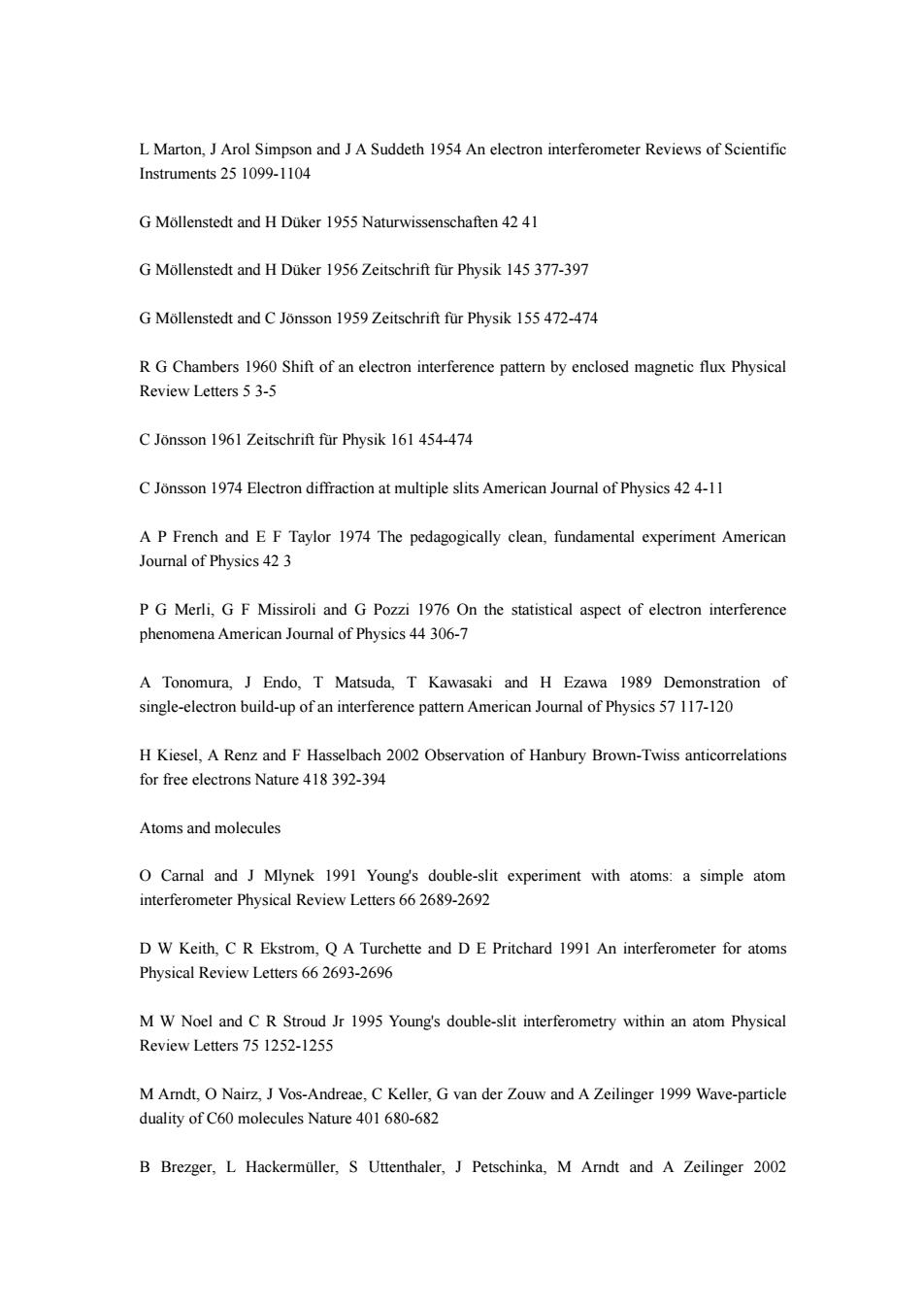
L Marton,J Arol Simpson and J A Suddeth 1954 An electron interferometer Reviews of Scientific Instruments 25 1099-1104 G Mollenstedt and H Duker 1955 Naturwissenschaften 42 41 G Mollenstedt and H Duker 1956 Zeitschrift fur Physik 145 377-397 G Mollenstedt and C Jonsson 1959 Zeitschrift fur Physik 155 472-474 R G Chambers 1960 Shift of an electron interference pattern by enclosed magnetic flux Physical Review Letters 5 3-5 C Jonsson 1961 Zeitschrift fur Physik 161 454-474 C Jonsson 1974 Electron diffraction at multiple slits American Journal of Physics 42 4-11 A P French and E F Taylor 1974 The pedagogically clean,fundamental experiment American Journal of Physics 42 3 P G Merli,G F Missiroli and G Pozzi 1976 On the statistical aspect of electron interference phenomena American Journal of Physics 44 306-7 A Tonomura,J Endo,T Matsuda,T Kawasaki and H Ezawa 1989 Demonstration of single-electron build-up of an interference pattern American Journal of Physics 57 117-120 H Kiesel,A Renz and F Hasselbach 2002 Observation of Hanbury Brown-Twiss anticorrelations for free electrons Nature 418 392-394 Atoms and molecules O Carnal and J Mlynek 1991 Young's double-slit experiment with atoms:a simple atom interferometer Physical Review Letters 66 2689-2692 D W Keith,C R Ekstrom,Q A Turchette and D E Pritchard 1991 An interferometer for atoms Physical Review Letters 66 2693-2696 M W Noel and C R Stroud Jr 1995 Young's double-slit interferometry within an atom Physical Review Letters 75 1252-1255 M Arndt,O Nairz,J Vos-Andreae,C Keller,G van der Zouw and A Zeilinger 1999 Wave-particle duality of C60 molecules Nature 401 680-682 B Brezger,L Hackermuller,S Uttenthaler,J Petschinka,M Arndt and A Zeilinger 2002
L Marton, J Arol Simpson and J A Suddeth 1954 An electron interferometer Reviews of Scientific Instruments 25 1099-1104 G Möllenstedt and H Düker 1955 Naturwissenschaften 42 41 G Möllenstedt and H Düker 1956 Zeitschrift für Physik 145 377-397 G Möllenstedt and C Jönsson 1959 Zeitschrift für Physik 155 472-474 R G Chambers 1960 Shift of an electron interference pattern by enclosed magnetic flux Physical Review Letters 5 3-5 C Jönsson 1961 Zeitschrift für Physik 161 454-474 C Jönsson 1974 Electron diffraction at multiple slits American Journal of Physics 42 4-11 A P French and E F Taylor 1974 The pedagogically clean, fundamental experiment American Journal of Physics 42 3 P G Merli, G F Missiroli and G Pozzi 1976 On the statistical aspect of electron interference phenomena American Journal of Physics 44 306-7 A Tonomura, J Endo, T Matsuda, T Kawasaki and H Ezawa 1989 Demonstration of single-electron build-up of an interference pattern American Journal of Physics 57 117-120 H Kiesel, A Renz and F Hasselbach 2002 Observation of Hanbury Brown-Twiss anticorrelations for free electrons Nature 418 392-394 Atoms and molecules O Carnal and J Mlynek 1991 Young's double-slit experiment with atoms: a simple atom interferometer Physical Review Letters 66 2689-2692 D W Keith, C R Ekstrom, Q A Turchette and D E Pritchard 1991 An interferometer for atoms Physical Review Letters 66 2693-2696 M W Noel and C R Stroud Jr 1995 Young's double-slit interferometry within an atom Physical Review Letters 75 1252-1255 M Arndt, O Nairz, J Vos-Andreae, C Keller, G van der Zouw and A Zeilinger 1999 Wave-particle duality of C60 molecules Nature 401 680-682 B Brezger, L Hackermüller, S Uttenthaler, J Petschinka, M Arndt and A Zeilinger 2002
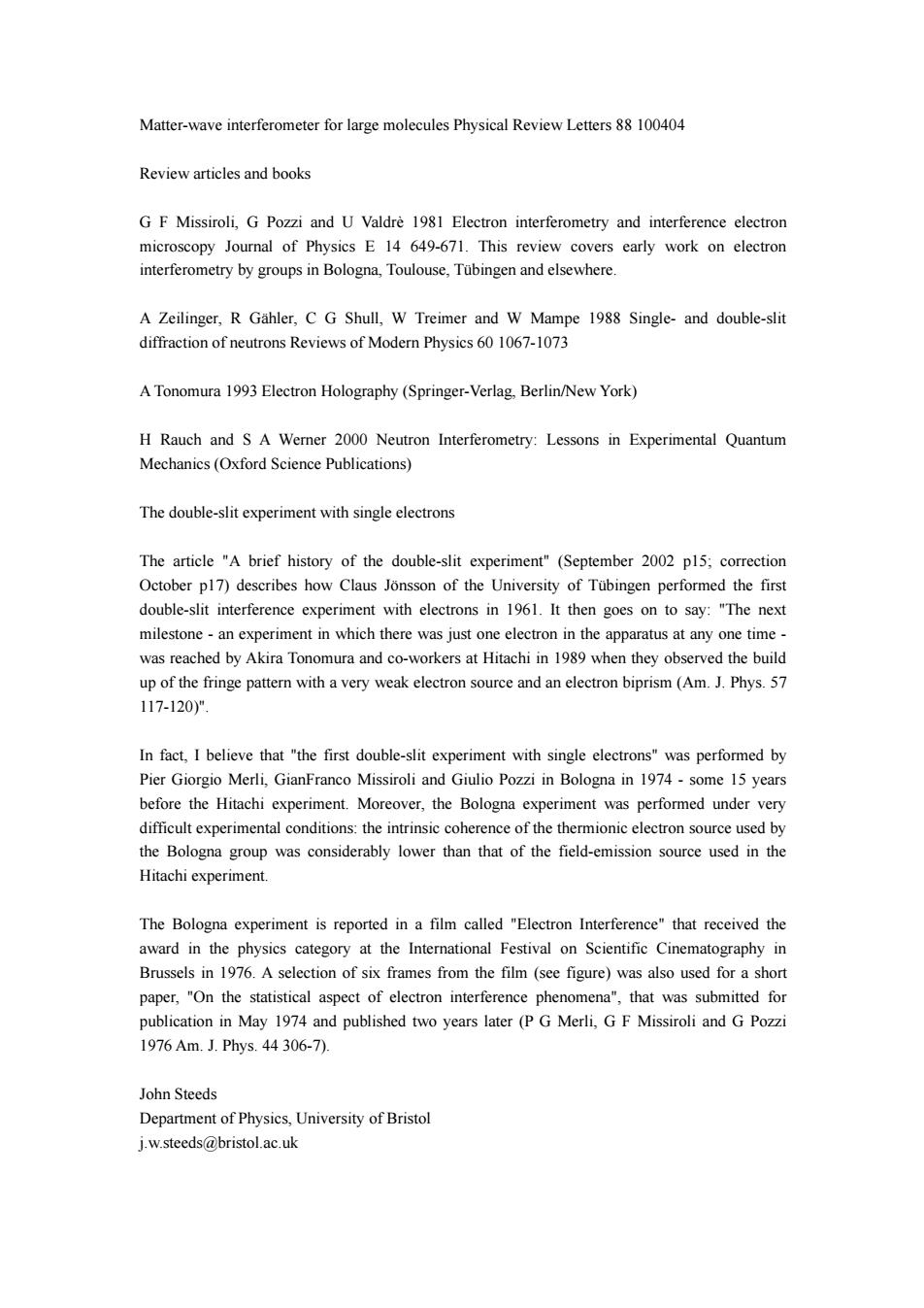
Matter-wave interferometer for large molecules Physical Review Letters 88 100404 Review articles and books G F Missiroli,G Pozzi and U Valdre 1981 Electron interferometry and interference electron microscopy Journal of Physics E 14 649-671.This review covers early work on electron interferometry by groups in Bologna,Toulouse,Tubingen and elsewhere. A Zeilinger,R Gahler,C G Shull,W Treimer and W Mampe 1988 Single-and double-slit diffraction of neutrons Reviews of Modern Physics 60 1067-1073 A Tonomura 1993 Electron Holography (Springer-Verlag,Berlin/New York) H Rauch and S A Werner 2000 Neutron Interferometry:Lessons in Experimental Quantum Mechanics (Oxford Science Publications) The double-slit experiment with single electrons The article "A brief history of the double-slit experiment"(September 2002 p15;correction October pl7)describes how Claus Jonsson of the University of Tubingen performed the first double-slit interference experiment with electrons in 1961.It then goes on to say:"The next milestone-an experiment in which there was just one electron in the apparatus at any one time- was reached by Akira Tonomura and co-workers at Hitachi in 1989 when they observed the build up of the fringe pattern with a very weak electron source and an electron biprism(Am.J.Phys.57 117-120)" In fact,I believe that "the first double-slit experiment with single electrons"was performed by Pier Giorgio Merli,GianFranco Missiroli and Giulio Pozzi in Bologna in 1974-some 15 years before the Hitachi experiment.Moreover,the Bologna experiment was performed under very difficult experimental conditions:the intrinsic coherence of the thermionic electron source used by the Bologna group was considerably lower than that of the field-emission source used in the Hitachi experiment. The Bologna experiment is reported in a film called "Electron Interference"that received the award in the physics category at the International Festival on Scientific Cinematography in Brussels in 1976.A selection of six frames from the film(see figure)was also used for a short paper,"On the statistical aspect of electron interference phenomena",that was submitted for publication in May 1974 and published two years later(P G Merli,G F Missiroli and G Pozzi 1976Am.J.Phys.44306-7). John Steeds Department of Physics,University of Bristol j.w.steeds(@bristol.ac.uk
Matter-wave interferometer for large molecules Physical Review Letters 88 100404 Review articles and books G F Missiroli, G Pozzi and U Valdrè 1981 Electron interferometry and interference electron microscopy Journal of Physics E 14 649-671. This review covers early work on electron interferometry by groups in Bologna, Toulouse, Tübingen and elsewhere. A Zeilinger, R Gähler, C G Shull, W Treimer and W Mampe 1988 Single- and double-slit diffraction of neutrons Reviews of Modern Physics 60 1067-1073 A Tonomura 1993 Electron Holography (Springer-Verlag, Berlin/New York) H Rauch and S A Werner 2000 Neutron Interferometry: Lessons in Experimental Quantum Mechanics (Oxford Science Publications) The double-slit experiment with single electrons The article "A brief history of the double-slit experiment" (September 2002 p15; correction October p17) describes how Claus Jönsson of the University of Tübingen performed the first double-slit interference experiment with electrons in 1961. It then goes on to say: "The next milestone - an experiment in which there was just one electron in the apparatus at any one time - was reached by Akira Tonomura and co-workers at Hitachi in 1989 when they observed the build up of the fringe pattern with a very weak electron source and an electron biprism (Am. J. Phys. 57 117-120)". In fact, I believe that "the first double-slit experiment with single electrons" was performed by Pier Giorgio Merli, GianFranco Missiroli and Giulio Pozzi in Bologna in 1974 - some 15 years before the Hitachi experiment. Moreover, the Bologna experiment was performed under very difficult experimental conditions: the intrinsic coherence of the thermionic electron source used by the Bologna group was considerably lower than that of the field-emission source used in the Hitachi experiment. The Bologna experiment is reported in a film called "Electron Interference" that received the award in the physics category at the International Festival on Scientific Cinematography in Brussels in 1976. A selection of six frames from the film (see figure) was also used for a short paper, "On the statistical aspect of electron interference phenomena", that was submitted for publication in May 1974 and published two years later (P G Merli, G F Missiroli and G Pozzi 1976 Am. J. Phys. 44 306-7). John Steeds Department of Physics, University of Bristol j.w.steeds@bristol.ac.uk

The history of science is not restricted to the achievements of big scientists or big scientific institutions.Contributions can also be made by researchers with the necessary background, curiosity and enthusiasm.In the period 1973-1974 we were investigating practical applications of electron interferometry with a Siemens Elmiskop 101 electron microscope that had been carefully calibrated at the CNR-LAMEL laboratory in Bologna,where one of us(PGM)was based (J.Phys. E7729-32) These experiments followed earlier work at the Istituto di Fisica in 1972-73 in which the electron biprism was inserted in a Siemens Elmiskop IA and then used both for didactic(Am.J.Phys.41 639-644)and research experiments (J.Microscopie 18 103-108).We used the Elmiskop 101 for many experiments including,for instance,the observation of the electrostatic field associated with p-n junctions (J.Microscopie 21 11-20). During this period we learnt that Professors Angelo and Aurelio Bairati in the Institute of Anatomy at the University of Milan had bought an image intensifier that could be used with the Elmiskop 101.Out of curiosity,and also realizing the conceptual importance of interference experiments with single photons or electrons,we asked if we could attempt to perform an interference experiment with single electrons in the Milan laboratory.Our results formed the basis of the film "Electron interference"and were also published in 1976(Am.J.Phys.44 306-7). Following the publication of the paper by Tonomura and co-workers in 1989,which did not refer to our 1976 paper (although it did contain an incorrect reference to our film),the American Journal of Physics published a letter from Greyson Gilson of Submicron Structures Inc.The letter stated:"Tonomura et al.seem to believe that they were the first to perform a successful two-slit interference experiment using electrons and also that they were the first to observe the cumulative build-up of the resulting electron interference pattern.Although their demonstration is very admirable,reports of similar work have appeared in this Journal for about 30 years (see,for examples,Refs.2-7.)It seems inappropriate to permit the widespread misconception that such experiments have not been performed and perhaps cannot be performed to continue."(G Gilson 1989 Am.J.Phys.57 680).Three of the seven papers that Gilson refers to were from our group in Bologna. Single-electron interference at BolognaThe main subject of our 1976 paper and the 1989 paper from the Hitachi group are the same:the single-electron build-up of the interference pattern and the statistical aspect of the phenomena.Obviously the electron-detection system used by the Hitachi group in 1989 was more sophisticated than the one we used in 1974.However,the sentence on page 118 of the paper by Tonomura et al.,which states that in our film we "showed the electron arrival in each frame without recording the cumulative arrivals",is not correct:this can be seen by watching the film and looking at figure 1 of our 1976 paper(a version of which is shown here). Finally,it is also worth noting that the first double-slit experiment with single electrons was actually a by-product of research into the practical applications of electron interferometry
The history of science is not restricted to the achievements of big scientists or big scientific institutions. Contributions can also be made by researchers with the necessary background, curiosity and enthusiasm. In the period 1973-1974 we were investigating practical applications of electron interferometry with a Siemens Elmiskop 101 electron microscope that had been carefully calibrated at the CNR-LAMEL laboratory in Bologna, where one of us (PGM) was based (J. Phys. E7 729-32). These experiments followed earlier work at the Istituto di Fisica in 1972-73 in which the electron biprism was inserted in a Siemens Elmiskop IA and then used both for didactic (Am. J. Phys. 41 639-644) and research experiments (J. Microscopie 18 103-108). We used the Elmiskop 101 for many experiments including, for instance, the observation of the electrostatic field associated with p-n junctions (J. Microscopie 21 11-20). During this period we learnt that Professors Angelo and Aurelio Bairati in the Institute of Anatomy at the University of Milan had bought an image intensifier that could be used with the Elmiskop 101. Out of curiosity, and also realizing the conceptual importance of interference experiments with single photons or electrons, we asked if we could attempt to perform an interference experiment with single electrons in the Milan laboratory. Our results formed the basis of the film "Electron interference" and were also published in 1976 (Am. J. Phys. 44 306-7). Following the publication of the paper by Tonomura and co-workers in 1989, which did not refer to our 1976 paper (although it did contain an incorrect reference to our film), the American Journal of Physics published a letter from Greyson Gilson of Submicron Structures Inc. The letter stated: "Tonomura et al. seem to believe that they were the first to perform a successful two-slit interference experiment using electrons and also that they were the first to observe the cumulative build-up of the resulting electron interference pattern. Although their demonstration is very admirable, reports of similar work have appeared in this Journal for about 30 years (see, for examples, Refs. 2-7.) It seems inappropriate to permit the widespread misconception that such experiments have not been performed and perhaps cannot be performed to continue." (G Gilson 1989 Am. J. Phys. 57 680). Three of the seven papers that Gilson refers to were from our group in Bologna. Single-electron interference at BolognaThe main subject of our 1976 paper and the 1989 paper from the Hitachi group are the same: the single-electron build-up of the interference pattern and the statistical aspect of the phenomena. Obviously the electron-detection system used by the Hitachi group in 1989 was more sophisticated than the one we used in 1974. However, the sentence on page 118 of the paper by Tonomura et al., which states that in our film we "showed the electron arrival in each frame without recording the cumulative arrivals", is not correct: this can be seen by watching the film and looking at figure 1 of our 1976 paper (a version of which is shown here). Finally, it is also worth noting that the first double-slit experiment with single electrons was actually a by-product of research into the practical applications of electron interferometry
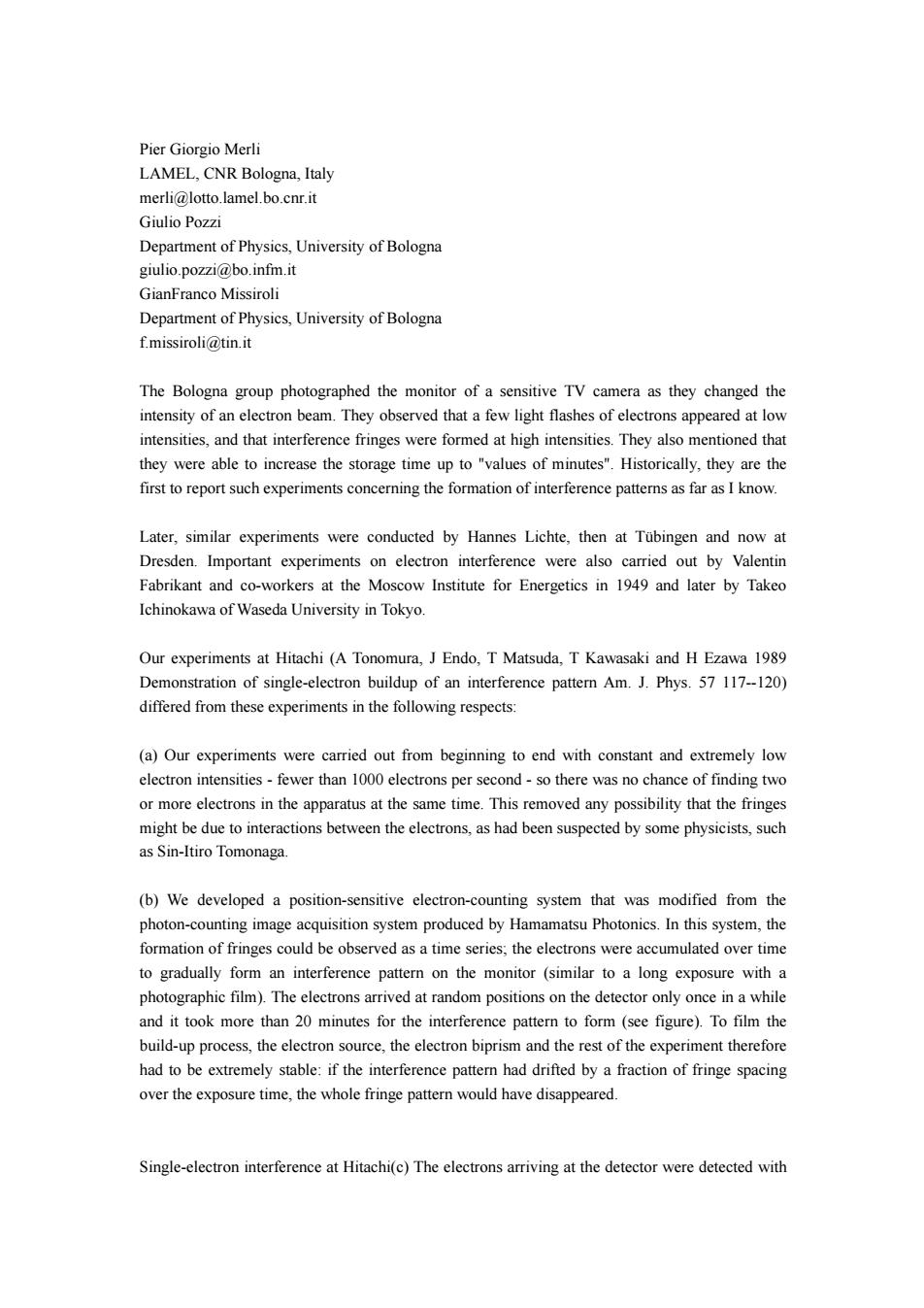
Pier Giorgio Merli LAMEL,CNR Bologna,Italy merli@lotto.lamel.bo.cnr.it Giulio Pozzi Department of Physics,University of Bologna giulio.pozzi@bo.infm.it GianFranco Missiroli Department of Physics,University of Bologna f.missiroli@tin.it The Bologna group photographed the monitor of a sensitive TV camera as they changed the intensity of an electron beam.They observed that a few light flashes of electrons appeared at low intensities,and that interference fringes were formed at high intensities.They also mentioned that they were able to increase the storage time up to "values of minutes".Historically,they are the first to report such experiments concerning the formation of interference patterns as far as I know. Later,similar experiments were conducted by Hannes Lichte,then at Tubingen and now at Dresden.Important experiments on electron interference were also carried out by Valentin Fabrikant and co-workers at the Moscow Institute for Energetics in 1949 and later by Takeo Ichinokawa of Waseda University in Tokyo. Our experiments at Hitachi (A Tonomura,J Endo,T Matsuda,T Kawasaki and H Ezawa 1989 Demonstration of single-electron buildup of an interference pattern Am.J.Phys.57 117--120) differed from these experiments in the following respects: (a)Our experiments were carried out from beginning to end with constant and extremely low electron intensities-fewer than 1000 electrons per second-so there was no chance of finding two or more electrons in the apparatus at the same time.This removed any possibility that the fringes might be due to interactions between the electrons,as had been suspected by some physicists,such as Sin-Itiro Tomonaga. (b)We developed a position-sensitive electron-counting system that was modified from the photon-counting image acquisition system produced by Hamamatsu Photonics.In this system,the formation of fringes could be observed as a time series;the electrons were accumulated over time to gradually form an interference pattern on the monitor (similar to a long exposure with a photographic film).The electrons arrived at random positions on the detector only once in a while and it took more than 20 minutes for the interference pattern to form (see figure).To film the build-up process,the electron source,the electron biprism and the rest of the experiment therefore had to be extremely stable:if the interference pattern had drifted by a fraction of fringe spacing over the exposure time,the whole fringe pattern would have disappeared. Single-electron interference at Hitachi(c)The electrons arriving at the detector were detected with
Pier Giorgio Merli LAMEL, CNR Bologna, Italy merli@lotto.lamel.bo.cnr.it Giulio Pozzi Department of Physics, University of Bologna giulio.pozzi@bo.infm.it GianFranco Missiroli Department of Physics, University of Bologna f.missiroli@tin.it The Bologna group photographed the monitor of a sensitive TV camera as they changed the intensity of an electron beam. They observed that a few light flashes of electrons appeared at low intensities, and that interference fringes were formed at high intensities. They also mentioned that they were able to increase the storage time up to "values of minutes". Historically, they are the first to report such experiments concerning the formation of interference patterns as far as I know. Later, similar experiments were conducted by Hannes Lichte, then at Tübingen and now at Dresden. Important experiments on electron interference were also carried out by Valentin Fabrikant and co-workers at the Moscow Institute for Energetics in 1949 and later by Takeo Ichinokawa of Waseda University in Tokyo. Our experiments at Hitachi (A Tonomura, J Endo, T Matsuda, T Kawasaki and H Ezawa 1989 Demonstration of single-electron buildup of an interference pattern Am. J. Phys. 57 117--120) differed from these experiments in the following respects: (a) Our experiments were carried out from beginning to end with constant and extremely low electron intensities - fewer than 1000 electrons per second - so there was no chance of finding two or more electrons in the apparatus at the same time. This removed any possibility that the fringes might be due to interactions between the electrons, as had been suspected by some physicists, such as Sin-Itiro Tomonaga. (b) We developed a position-sensitive electron-counting system that was modified from the photon-counting image acquisition system produced by Hamamatsu Photonics. In this system, the formation of fringes could be observed as a time series; the electrons were accumulated over time to gradually form an interference pattern on the monitor (similar to a long exposure with a photographic film). The electrons arrived at random positions on the detector only once in a while and it took more than 20 minutes for the interference pattern to form (see figure). To film the build-up process, the electron source, the electron biprism and the rest of the experiment therefore had to be extremely stable: if the interference pattern had drifted by a fraction of fringe spacing over the exposure time, the whole fringe pattern would have disappeared. Single-electron interference at Hitachi(c) The electrons arriving at the detector were detected with

almost 100%efficiency.Counting losses and noise in conventional TV cameras mean that it is difficult to know if each flash of the screen really corresponds to an individual electron.Therefore, the detection error in our experiment was limited to less than 1%. We believe that we carried out the first experiment in which the build-up process of an interference pattern from single-electron events could be seen in real time as in Feynman's famous double-slit Gedanken experiment under the condition,we emphasize,that there was no chance of finding two or more electrons in the apparatus. Akira Tonomura Hitachi Advanced Research Laboratory,Saitama,Japan tonomura@harl.hitachi.co.jp About the author Peter Rodgers is Editor of Physics World
almost 100% efficiency. Counting losses and noise in conventional TV cameras mean that it is difficult to know if each flash of the screen really corresponds to an individual electron. Therefore, the detection error in our experiment was limited to less than 1%. We believe that we carried out the first experiment in which the build-up process of an interference pattern from single-electron events could be seen in real time as in Feynman's famous double-slit Gedanken experiment under the condition, we emphasize, that there was no chance of finding two or more electrons in the apparatus. Akira Tonomura Hitachi Advanced Research Laboratory, Saitama, Japan tonomura@harl.hitachi.co.jp About the author Peter Rodgers is Editor of Physics World